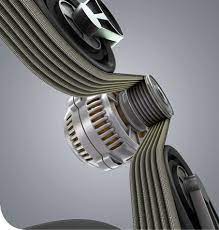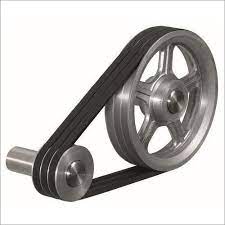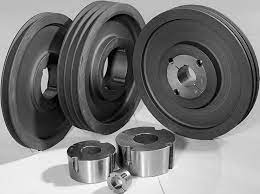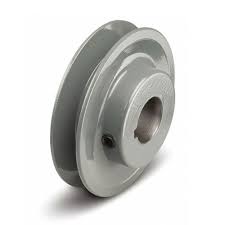Product Description
Product Description
1.Teeth Profile:
|
HTD: |
3M,5M,8M,14M,20M |
|||
|
T&AT: |
T2.5,T5,T10, AT5,AT10,AT20 |
|||
|
STPD: |
S2M,S3M,S4.5M,S5M,S8M,S14M |
|||
|
RPP: |
5M,8M,14M,20M |
|||
|
PGGT (PowerGrip GT): |
2MR,3MR,5MR,8MR,14MR |
|||
2. Materials:
Aluminum timing pulleys
Characteristics:
1.suitable for moderate power transmission
2.light weight / reduced rotational inertia
3.moderate chemical and corrosion resistance
4.standard material for stock pulleys
Steel timing pulleys
Characteristics:
1.suitable for high power transmission
2.durable
3.limited chemical and corrosion resistance
4.aesthetic material
3.Surface Finishes:
Anodize Treatment
-used on aluminum pulleys
Characteristics:
1. Increased chemical and corrosion resistance
2. Available in natural, black, or colored
3. Limited increase of surface hardness
4. Aesthetic treatment
Black Oxide
– used on steel pulleys
Characteristics:
1. Increased chemical and corrosion resistance
2. Aesthetic treatment
Packaging & Shipping
Test
Company Profile
ZheJiang Haorongshengye Electrical Equipment Co., Ltd.
1. Was founded in 2008
2. Our Principle:
“Credibility Supremacy, and Customer First”
3. Our Promise:
“High quality products, and Excellent Service”
4. Our Value:
“Being Honesty, Doing the Best, and Long-lasting Development”
5. Our Aim:
“Develop to be a leader in the power transmission parts industry in the world”
|
6.Our services: |
1).Competitive price |
|||
|
2).High quality products |
||||
|
3).OEM service or can customized according to your drawings |
||||
|
4).Reply your inquiry in 24 hours |
||||
|
5).Professional technical team 24 hours online service |
||||
|
6).Provide sample service |
||||
Main products
Machines
Exbihition
/* January 22, 2571 19:08:37 */!function(){function s(e,r){var a,o={};try{e&&e.split(“,”).forEach(function(e,t){e&&(a=e.match(/(.*?):(.*)$/))&&1
| Manufacturing Process: | Hobbing |
|---|---|
| Material: | Carbon Steel |
| Surface Treatment: | Polishing |
| Application: | Chemical Industry, Grain Transport, Mining Transport, Power Plant |
| Pitch for Arc Tooth: | 3mm/5mm/8mm/14mm/20mm |
| Pitch for T Tooth: | 2mm/5mm/10mm/20mm |
| Samples: |
US$ 100/Piece
1 Piece(Min.Order) | |
|---|
| Customization: |
Available
| Customized Request |
|---|

What are some real-world examples of drive belt pulley applications in various industries?
There are numerous real-world examples of drive belt pulley applications across various industries. Here’s a detailed explanation of some common examples:
1. Automotive Industry:
– Engine Systems: Drive belt pulleys are used in automotive engines to transmit power from the crankshaft to various engine accessories, such as the alternator, power steering pump, water pump, and air conditioning compressor. These pulleys ensure the proper functioning of these components and provide efficient power distribution in the engine system.
– Timing Systems: Timing pulleys and belts are employed in automotive engines to synchronize the rotation of the camshaft and crankshaft. This precise timing is crucial for the opening and closing of engine valves in coordination with the piston movement, ensuring optimal engine performance and fuel efficiency.
2. Industrial Machinery:
– Conveyor Systems: Drive belt pulleys are utilized in conveyor systems to transfer power from motors to conveyor belts. They enable the movement of materials, products, or components along the conveyor line, facilitating efficient material handling in industries such as manufacturing, logistics, and mining.
– Machine Tools: Drive belt pulleys are found in various machine tools, such as lathes, milling machines, and drills, to transmit power from the motor to the spindle or cutting tool. These pulleys allow for precise speed control and power transmission, ensuring accurate machining operations.
– Printing Presses: Timing pulleys and belts are used in printing presses to synchronize the movement of printing plates, ensuring precise registration and consistent print quality. The pulleys enable accurate timing and reliable power transmission for the complex mechanisms involved in the printing process.
3. HVAC Systems:
– Air Handling Units: Drive belt pulleys are employed in air handling units to drive fans and blowers that circulate air in heating, ventilation, and air conditioning (HVAC) systems. These pulleys enable efficient airflow and temperature control in commercial and residential buildings.
4. Agricultural Machinery:
– Tractors and Farm Equipment: Drive belt pulleys are used in tractors and various farm equipment to transfer power from the engine to components such as pumps, augers, conveyors, and cutting mechanisms. These pulleys enable tasks like plowing, planting, harvesting, and material handling in agricultural operations.
– Harvesting Machinery: Agricultural machinery like combines and forage harvesters employ drive belt pulleys to power the cutting mechanisms, threshing systems, and grain separation mechanisms. These pulleys ensure efficient harvesting and grain processing in the agricultural industry.
5. Fitness Equipment:
– Treadmills and Exercise Bikes: Drive belt pulleys are utilized in fitness equipment like treadmills and exercise bikes to transfer power from the motor to the running belt or pedals. These pulleys allow for adjustable speed control and smooth operation, providing users with an effective workout experience.
6. Construction Equipment:
– Concrete Mixers: Drive belt pulleys are used in concrete mixers to transmit power from the engine to the mixing drum. These pulleys enable efficient mixing of concrete during construction projects, ensuring uniformity and consistency in concrete production.
– Cranes and Hoists: Drive belt pulleys can be found in cranes and hoists to transmit power from the motor to the lifting mechanisms. These pulleys provide the necessary torque and speed control for lifting heavy loads in construction sites and industrial settings.
These examples highlight the wide range of applications of drive belt pulleys across industries, from automotive and industrial machinery to HVAC, agriculture, fitness equipment, and construction. Drive belt pulleys play a crucial role in power transmission, speed control, and reliable operation in various mechanical systems, contributing to the efficiency and functionality of these industries.

What role do drive belt pulleys play in air conditioning and alternator systems?
Drive belt pulleys play a crucial role in both air conditioning and alternator systems in automotive applications. Here’s a detailed explanation of the role drive belt pulleys play in these systems:
Air Conditioning System:
In an automotive air conditioning system, the drive belt pulley is responsible for transmitting power from the engine’s crankshaft to the air conditioning compressor. The air conditioning compressor is a key component that pressurizes and circulates the refrigerant throughout the system, allowing for the cooling and dehumidification of the air inside the vehicle’s cabin.
The drive belt pulley is connected to the engine’s crankshaft, and as the engine rotates, it drives the pulley, which in turn spins the air conditioning compressor. This rotational motion of the compressor enables it to compress and circulate the refrigerant, absorbing heat from the cabin and releasing it outside, resulting in the cooling effect.
By driving the air conditioning compressor, the drive belt pulley ensures the proper functioning of the air conditioning system. It allows for the regulation of the compressor’s speed and power output, controlling the cooling capacity of the system based on the cabin temperature and the desired comfort level.
Alternator System:
In an automotive alternator system, the drive belt pulley is responsible for driving the alternator, which is a critical component for generating electrical power and charging the vehicle’s battery. The alternator converts mechanical energy from the engine’s rotation into electrical energy, supplying power to the electrical systems and recharging the battery while the engine is running.
The drive belt pulley is connected to the engine’s crankshaft, and as the engine rotates, it drives the pulley, which in turn spins the alternator. The rotational motion of the pulley drives the alternator’s internal rotor, which is surrounded by a stator and a set of windings. This relative motion between the rotor and stator induces an electrical current in the windings, generating the electrical power output.
The drive belt pulley ensures that the alternator operates at the correct speed and power output to meet the electrical demands of the vehicle. It provides the necessary mechanical power to drive the alternator and generate the required electrical energy, supplying power to the vehicle’s electrical systems, including the lights, ignition system, audio system, and various other electronic components.
Additionally, the drive belt pulley in the alternator system plays a role in the battery charging process. As the alternator generates electrical power, it also recharges the vehicle’s battery, ensuring that it remains charged and ready to supply electrical energy when the engine is not running or when the electrical load exceeds the alternator’s output capacity.
Overall, drive belt pulleys are essential components in both air conditioning and alternator systems in automotive applications. They facilitate the transfer of power from the engine’s crankshaft to the air conditioning compressor and alternator, enabling the proper functioning of these systems and ensuring the comfort and electrical reliability of the vehicle.

What types of drive belts are typically employed with drive belt pulleys?
Drive belt pulleys are commonly used in conjunction with different types of drive belts, depending on the specific application and requirements. Here’s a detailed explanation of the types of drive belts typically employed with drive belt pulleys:
1. V-Belts:
V-belts are one of the most commonly used types of drive belts with drive belt pulleys. They have a trapezoidal cross-section and typically feature a fabric cover and rubber construction. V-belts are designed to fit into the V-shaped grooves of the pulley and provide reliable power transmission. They are known for their flexibility, high friction grip, and ability to handle high-speed applications. V-belts are commonly used in automotive engines, industrial machinery, and various power transmission systems.
2. Serpentine Belts:
Serpentine belts, also known as multi-rib belts, have a flat cross-section with multiple ribs on one side. These belts wrap around multiple pulleys, including drive belt pulleys, in a serpentine pattern. Serpentine belts are commonly used in modern vehicles as they can drive multiple components simultaneously, such as the alternator, water pump, power steering pump, air conditioning compressor, and more. They offer efficient power transmission, high load-carrying capacity, and reduced slippage.
3. Timing Belts:
Timing belts, also referred to as toothed belts, have teeth on the inner side that mesh with corresponding grooves in timing pulleys. These belts are primarily used in engines to synchronize the rotation of the crankshaft and camshaft, ensuring precise valve timing. Timing belts are made of a flexible, reinforced material, usually rubber with embedded fibers or cords, providing excellent power transmission and resistance to wear. They are commonly used in automotive engines and other applications where timing precision is critical.
4. Flat Belts:
Flat belts have a rectangular cross-section and are made of materials such as rubber, leather, or fabric. They are often employed in applications where high-speed power transmission is required with minimal vibration and noise. Flat belts typically run on flat pulleys, which can include drive belt pulleys. They are commonly used in industrial machinery, agricultural equipment, and conveyor systems.
5. Ribbed Belts:
Ribbed belts, also known as micro V-belts or multi-rib belts, have a ribbed cross-section with multiple longitudinal ribs on one side. These ribs fit into corresponding grooves on the pulley, providing a larger contact area and enhanced power transmission capabilities. Ribbed belts are commonly used in automotive engines, power tools, and appliances. They offer high flexibility, excellent grip, and can transmit higher loads compared to standard V-belts.
6. Variable Speed Belts:
Variable speed belts, also called adjustable speed belts or link belts, are designed to provide a variable speed drive. They consist of multiple individual links connected by metal or plastic hinges. These belts can be adjusted in length by adding or removing links, allowing for flexibility in speed and torque transmission. Variable speed belts are commonly used in applications where speed variation is required, such as HVAC systems, agricultural machinery, and industrial equipment.
These are some of the types of drive belts typically employed with drive belt pulleys. The selection of the appropriate drive belt depends on factors such as the application, power requirements, speed, load, and specific performance characteristics needed for optimal power transmission.


editor by CX
2024-04-30














